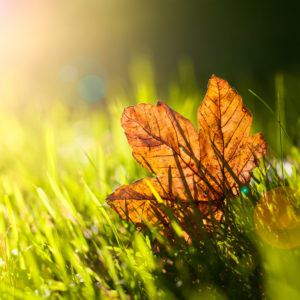 Mowing and Leaf Removal in Late Fall – All lawns should be closely mown and leaf-free when the growing season ends and the ground freezes solid. Whether you mow your own lawn or have a lawn-mowing service do it for you, please continue the job until beyond Thanksgiving. Frequency of mowing has already been stretched out to every 7-10 days and will continue to lengthen as growth slows, but our cool season grasses will continue to grow until soil temperatures drop below 40 degrees F., or until mid-December. Leaves will continue to drop until well into December also, and we want you to keep them from accumulating on the lawns. Long blades and unremoved leaves tend to mat down on the lawns and smother the grass. Continued mowing reduces this problem greatly. Also, as we get deeper into the fall and early winter and as the days get shorter, it’ll take a lot longer for the lawns to dry, yet we want you to try to only mow lawns when the blades are “relatively” dry. This means afternoon mowing is better than earlier in the day. Mowing wet grass can damage the turf, particularly if there’s young grass in the lawn.
Mowing and Leaf Removal in Late Fall – All lawns should be closely mown and leaf-free when the growing season ends and the ground freezes solid. Whether you mow your own lawn or have a lawn-mowing service do it for you, please continue the job until beyond Thanksgiving. Frequency of mowing has already been stretched out to every 7-10 days and will continue to lengthen as growth slows, but our cool season grasses will continue to grow until soil temperatures drop below 40 degrees F., or until mid-December. Leaves will continue to drop until well into December also, and we want you to keep them from accumulating on the lawns. Long blades and unremoved leaves tend to mat down on the lawns and smother the grass. Continued mowing reduces this problem greatly. Also, as we get deeper into the fall and early winter and as the days get shorter, it’ll take a lot longer for the lawns to dry, yet we want you to try to only mow lawns when the blades are “relatively” dry. This means afternoon mowing is better than earlier in the day. Mowing wet grass can damage the turf, particularly if there’s young grass in the lawn.
Fertilizing with LAWN DEPOT WINTERFEAST – The late fall, toward the end of the grass growing season, when roots and crowns are still active but blade growth has greatly slowed, is the most important feeding time of the year. Roots grow deeper and thicker in the still-warm soil, while blades green up but don’t grow much. Lawns stay green longer into the fall and green up faster in the spring. Lawns that have been damaged by difficult growing conditions this summer and fall will thicken and recover better with the late fall feeding. Lawn Depot WINTERFEAST fertilizers are the most complete fertilizers available at this time of the year. It’s why our lawns, both DIY lawns and Turf Management lawns look better in late fall and early spring, and are thicker and healthier going into next year. Fertilize with WINTERFEAST after the first hard frost (anytime now) and before the ground freezes solid in mid-December or beyond.
Seeding in November and Beyond – Seed is still germinating as I write this Newsletter. The earth is still quite warm. Conditions continue to be favorable for Lawn Depot EVERGREEN perennial ryegrass mix to germinate, but it is now too late in the fall to sow any Tall Fescue or Bluegrass seed mixes and expect germination this fall. Therefore, seed only with EVERGREEN MIX, and even then, only seed if it’s absolutely necessary. Although ungerminated seed will remain viable over the winter, it will make any crabgrass or broadleaf weed control next spring difficult. Seed that has already been sown will continue germinating for another several weeks, or until soil temperatures drop below the low 40s. If the seed has been sown on bare earth, remember that you won’t have the benefit of the heavy morning dews, so regular, light watering (as many as several times a day through germination) will greatly benefit germination.
Liming Lawns in the Late Fall – Lime is a soil conditioner, not a fertilizer. Lime sweetens the soil (neutralizes soil acidity) which in turn, makes fertilizers work better. With our naturally acidic soils, lawns should be limed REGULARLY, at least once a year. Lime can be applied whenever the ground isn’t frozen. Apply pelletized lime at the rate of 15 lbs./1,000 sq. ft. if you lime regularly, or at the rate of 50 lbs./1,000 sq. ft. if you haven’t limed for several years. Applying less than the recommended maintenance rate is of no value, so don’t stretch the bag coverage.

Hi, this is a comment.
To get started with moderating, editing, and deleting comments, please visit the Comments screen in the dashboard.
Commenter avatars come from Gravatar.